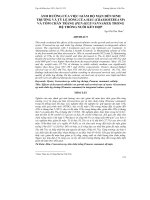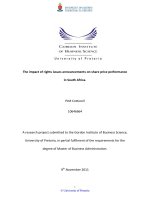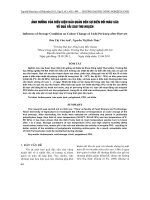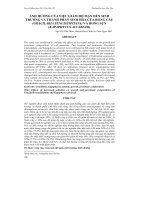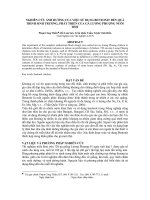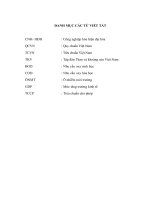Ảnh hưởng của việc thông báo quyền đến giá cổ phiếu - the impact of the rights issue announcements on share price
Bạn đang xem bản rút gọn của tài liệu. Xem và tải ngay bản đầy đủ của tài liệu tại đây (794.81 KB, 63 trang )
The impact of rights issues announcements on share price performance
in South Africa.
PJM Cotterell
10646664
A research project submitted to the Gordon Institute of Business Science,
University of Pretoria, in partial fulfilment of the requirements for the
degree of Master of Business Administration.
9th November 2011
i
© University of Pretoria
Abstract
Rights issues are an area of much interest and research globally. With the last significant local
study on the topic conducted in 2005, this paper updates the findings based on more recent
data. This is also the first study to explore the impact that the
financial position has
on the share price reaction to the announcement.
The study was conducted by analysing rights issue announcements occurring on the JSE
between 1st January 2001 and 31st December 2010. 35 events were used in this study since
they met the criteria for clean measurement. A standard event study methodology was used.
Abnormal returns were measured through both the market model and control portfolio, with
Statistical analysis
was conducted throughout to confirm significance.
Average Abnormal Returns of -2.33% and -3.30% were found on the day of the announcement,
depending on the model used, and Cumulative Average Abnormal Returns (CAARs) for five
days post the announcement were between -5% and -6%. Of most interest, share price
reactions were found to differ, with statistical significance, according to the financial position
of the issuer. Companies categorised as healthy recovered from the initial decline to a CAAR of
less than -1% twenty days post the announcement. In contrast companies categorised as
unhealthy and in the grey zone suffered CAARs after the same period of -9.17% and -8.06%
respectively. The conclusion of the study is that the well-researched share price decline on the
announcement of a rights issue persists, but that this reaction is significantly worse for
companies in a poor financial position, as measured by their Altman Z Score.
Keywords
Rights Issues, capital structure
ii
Declaration
I declare that this research project is my own work. It is submitted in partial fulfilment of the
requirements for the degree of Master of Business Administration at the Gordon Institute of
Business Science, University of Pretoria. It has not been submitted before for any degree or
examination in any other University. I further declare that I have obtained the necessary
authorisation and consent to carry out this research.
7th November 2011
PAUL JONATHAN MARK COTTERELL
iii
Acknowledgements
I was pleased to have Professor Mike Ward allocated as my supervisor and thank him for
letting me piggy back on his enormous knowledge on this subject, as well as for his efforts far
beyond that required for supervision.
Thank you also to my classmates Philip Tillman and Craig Miller who served as a great support
and encouragement through this lengthy process. Craig, specifically for topic specific
assistance, and Philip for the general guidance and amusing pranks played on classmates, GIBS
faculty, and occasionally myself throughout the MBA. Adam Martin assisted with the statistics
for the study thank you Adam for the speed, professionalism and patience as I changed the
requirements.
Thank you to my uncle and boss Tony Cotterell, colleagues, friends and family for the
understanding and often taking second place to the demands of my MBA over the past two
years, I look forward to making up for it!
Lastly but most importantly, glory and thanks to my Lord Jesus Christ who gives me life.
Dedication
I dedicate this work to the memory of Lucy Cotterell, fondly remembered and missed by our
family and her many friends around and about East London.
iv
TABLE OF CONTENTS
1.
DEFINITION OF PROBLEM AND PURPOSE ............................................................................. 1
1.1
1.2
Introduction to Research .............................................................................................. 1
1.3
Research Problem and Purpose .................................................................................... 1
1.4
Research Context: The JSE ............................................................................................ 3
1.5
Research Motivation ..................................................................................................... 3
1.6
2.
Research Title ................................................................................................................ 1
Research Objectives ...................................................................................................... 3
THEORY AND LITERATURE REVIEW ....................................................................................... 5
2.1
2.2
Introduction to Capital Structures ................................................................................ 6
2.3
Drivers of Financing Decisions and Market Timing ....................................................... 7
2.4
Market Timing and Rights Issues................................................................................... 9
2.5
Market Reactions to Rights Issues and Post-Issue Performance ................................ 10
2.6
Factors Influencing Performance of Issuing Companies ............................................. 11
2.7
Rights Issues by Companies in Financial Distress ........................................................ 12
2.8
The Altman Z Score as a Measure of Financial Distress .............................................. 13
2.9
Influences of the Size of the Rights Issue .................................................................... 13
2.10
Event Studies ............................................................................................................... 14
2.11
3.
Introduction to Rights Issues ......................................................................................... 5
Measuring Abnormal Returns ..................................................................................... 15
RESEARCH HYPOTHESES ...................................................................................................... 19
3.1
3.2
4.
Hypothesis 1: ............................................................................................................... 19
Hypothesis 2: ............................................................................................................... 19
RESEARCH METHODOLOGY AND DESIGN ........................................................................... 21
4.1
Unit of Analysis............................................................................................................ 21
4.2
Population ................................................................................................................... 21
4.3
Exclusions from Sample............................................................................................... 21
4.4
Screening of Sample .................................................................................................... 22
4.4.1
Rights Issues Excluded due to Simultaneous Announcements of Results .......... 23
4.4.2
Rights Issues Excluded due to Simultaneous Announcements of Acquisitions or
Material Transactions.......................................................................................................... 24
4.4.3
Rights Issues Excluded due to Simultaneous Announcements of Major
Restructures ........................................................................................................................ 25
v
4.4.4
Rights Issues Excluded due to Absence of Data .................................................. 26
4.4.5
Rights Issues Excluded on the Basis of Illiquidity ................................................ 26
4.4.6
Other Exclusions .................................................................................................. 27
4.5
Resulting Sample ......................................................................................................... 27
4.6
Altman Z Scores ........................................................................................................... 27
4.7
Data Collection ............................................................................................................ 31
4.8
Data Integrity .............................................................................................................. 32
4.9
Event Window ............................................................................................................. 33
4.10
Data Analysis ............................................................................................................... 33
4.10.1
Calculation of Means and Graphs ....................................................................... 33
4.10.2
One-Sample T-Tests ............................................................................................ 33
4.10.3
Independent T-Tests ........................................................................................... 34
4.10.4
Boot-Strapping .................................................................................................... 34
4.11
5.
Research Limitations ................................................................................................... 35
RESULTS ............................................................................................................................... 36
5.1
5.2
Cumulative Average Abnormal Returns ...................................................................... 38
5.3
Descriptive Statistics on Data Grouped by Altman Z Score and Statistical Testing .... 40
5.4
Average Abnormal Returns grouped by Altman Z Score ............................................ 41
5.5
6.
Daily Average Abnormal Returns ................................................................................ 36
Cumulative Average Abnormal Returns Grouped by Altman Z Score......................... 44
DISCUSSION OF RESULTS ..................................................................................................... 46
6.1
Hypothesis 1 ................................................................................................................ 46
6.2
Hypothesis 2 ................................................................................................................ 48
7.
CONCLUSION ....................................................................................................................... 51
8.
REFERENCES ........................................................................................................................ 53
9.
APPENDICES ........................................................................................................................ 55
9.1
Daily CAAR for Full Window ........................................................................................ 55
9.2
Daily CAR for Full Window - Altman Z Score Groups .................................................. 56
9.3
Daily CAR for full window - Revised Altman Z Score Groups for Statistical Analysis .. 57
vi
1. DEFINITION OF PROBLEM AND PURPOSE
1.1 Research Title
The impact of rights issues announcements on share price performance in South Africa.
1.2 Introduction to Research
The research analyses the share price performance of companies in the period immediately
prior and post their announcing a rights issue. The document begins by outlining the research
problem and motivation. A review of relevant literature follows, exploring the existing
knowledge on share price performance around rights issues announcements. From this,
hypotheses were developed and the methodology provided. Results are then detailed,
discussed and conclusions drawn.
1.3 Research Problem and Purpose
Rights issues have been the subject of much research by academics and practitioners for over
two decades (Bayless & Jay, 2008, p. 291). Many aspects of share price performance are
commonly accepted, such as general declines in share price on the announcement date
observed in many studies, from older studies conducted in South Africa (Bhana, 1999, p. 35) to
recent studies conducted in China (Shahid, Xinping, Mahmood, & Usman, 2010, p. 166).
While such broad principles around share price performance are accepted, we find differences
across markets as well as over different time periods. The difference between markets is well
illustrated by comparing the average 3% decline in US markets around announcement date
(Eckbo, Masulis, & Norli, 2000, p. 38) to the various price movements around different
announcements in the Chinese market (Shahid, Xinping, Mahmood, & Usman, 2010, p. 166).
These differences are partly attributable to differences in regulatory frameworks (Shahid,
Xinping, Mahmood, & Usman, 2010, p. 166), and shall be further expanded upon in the
1
literature review. This example illustrates the importance for studies within specific markets,
such as the JSE as the population for this research.
Differences are also identified during different time periods. South African studies over
different time periods have produced different results, with a study over 1980 1995 (Bhana,
1999) showing different average movements to a study conducted from 1989 to 2002 (Pascoe,
Ward, & MacKenzie, 2005, p. 18). The last significant study found on the South African market
was conducted on market data the most recent of which is 9 years old (Pascoe, Ward, &
MacKenzie, 2005). The global financial crisis, which occurred subsequent to that study and
during the period which this research covers, gave further cause for this study.
The last purpose of the research was in-line with the time period covering the global financial
crisis, consider
issue announcement. This has not previously been studied on the JSE, and is a specific area
not given much attention in international studies on rights issues. A number of studies have
investigated the influences of such factors, including governance (Dbouk & Ismail, 2010),
economic factors (Pascoe, Ward, & MacKenzie, 2005) and disclosure (Jo & Kim, 2008),
demonstrating the academic interest of specific factors.
The research conducted thus contributes to the existing knowledge on rights issues through
analysis specific to the JSE, over a more recent time period, and considering
financial position as described.
In addition to academic interest, the study may find interest amongst private and professional
investors, as well as to the boards of public companies who may consider using rights issues to
raise equity.
2
1.4 Research Context: The JSE
The research wa
sured by its
market capitalization of $182 billion (ADVFN, 2011)
classification as an emerging market (MSCI, 2011).
ion in the global competitiveness report reflects
positively on the JSE. The country scores 2nd in the world for the regulation of securities
exchanges, 4th for financing through local equity market and 6th for financial market
sophistication (World Economic Forum, 2009, p. 238).
The size of the JSE and the high-regard in which it is held internationally make it an appropriate
market for research, and give significance to the findings.
1.5 Research Motivation
The topic was inspired through a discussion with Mr Andy Russell of Nvest Securities in East
London. He is an experienced and highly-respected stock-broker and investor. On discussing
rights issues, he noted the typical negative market reaction to the announcement which has
been confirmed by the literature described above and in the literature review. He pondered,
however, as to a bit more insight into this and the influences.
This motivated a review of existing research on rights issues, which found a gap in local
research as described in the research purpose.
1.6 Research Objectives
The research had three objectives:
1. To extract relevant existing theory on rights issues and their impact on share price
performance.
3
2. To quantify the impacts of rights issues announcements on share price performance of
companies listed on the JSE from January 2001 to December 2010.
3. To explore whether the financial position of the issuer influences the impact quantified
in terms of the second objective.
4
2. THEORY AND LITERATURE REVIEW
2.1 Introduction to Rights Issues
The primary process through which new shares of listed companies in South Africa are issued
as a means to raise equity is a rights issue, the focus of this research. Rights issues give
existing shareholders the option of purchasing new shares, normally issued at a discount to the
prevailing market price (Lambrechts & Mostert, 1980, p. 25) to encourage participation in the
capital raising over purchasing shares in the market. Critically, existing shareholders of the
company benefit from a pre-emptive right to participate in the new issue in proportion to their
shareholding, providing the opportunity of avoiding a dilution in their proportionate ownership
in the company (Shahid, Xinping, Mahmood, & Usman, 2010, p. 163). This opportunity is
particularly material in the event of a significant discount on the new shares being issued, as
existing shareholders would otherwise be unable to mitigate the negative effect of such an
issue. This preference for rights issues is evidenced in reality, by way of example, The
announcements outlined the requirements for additional funding with preliminary results, and
that they were pursuing the funding by way of a convertible debt instrument. The further
announcement on 21st
Subsequent to the publication of above
cautionary announcement, numerous Dawn shareholders notified the company that they
would wish to participate in a capital raising programme initiated by the company.
Consequently Dawn has withdrawn from pursuing the convertible bond transaction and will be
(Distribution and Warehousing Network Limited,
2009). Shareholders may also sell their rights should they not wish to purchase the additional
shares.
Another means of raising equity through issuing new shares is through public offerings, also
with new shares being offered to the public,
5
while in private placements, shares are offered to institutions or high-net worth individuals
(Shahid, Xinping, Mahmood, & Usman, 2010, p. 163). The focus of the research will be
specifically rights issues, but for literature review purposes this will broadly encompass the
other forms of issuing new shares discussed, with terminology being used interchangeably.
Comprehensive literature already exists on rights issues (Bayless & Jay, 2008, p. 291), which
shall be explored as the basis of this study.
2.2 Introduction to Capital Structures
Underlying the decision for a firm to perform a rights issue is its capital structure. A firm
chooses to finance its operations through a balance of equity and debt, resulting in its financial
leverage, and early theory argues that this is normally done with a target ratio of debt to
equity in mind, as well as a target level of short-term debt to long-term (Marsh, 1982, p. 122).
A primary benefit of debt in this trade-off decision is the tax-deductibility of interest (Fama &
French, 2005, pp. 549-550), the importance of which has been stressed and widely accepted
for some time (Marsh, 1982, p. 122). The primary negatives of debt are potential bankruptcy
(Fama & French, 2005, pp. 549-550) and financial distress, with higher levels of equity
financing reducing this risk (Marsh, 1982, p. 122). In this model, the tax rate will therefore be
greatly influential in setting target capital structure, but more important will be the probability
of financial distress, giving a reasonable expectation that companies with higher operating risk
should use less debt in their capital structure (Marsh, 1982, p. 122).
Much research has been dedicated to the search for the optimal trade-off between debt and
equity (Myers & Lakshmi, 1999, p. 220). Firms are found to give cognisance to the factors
described as well as company size and asset composition in choosing their target debt levels
(Marsh, 1982, p. 142). In practice, financial leverage fluctuates, varying from the target level
6
as the business operates, and in which circumstances the firm should be issuing equity when
debt is above its target, and the opposite when debt is below the target.
If a firm intends to reduce its leverage by adding equity to its capital structure, it can do so
through foregoing the payment of dividends, or through the issue of new shares, which are
restrained due to transaction costs (Marsh, 1982, p. 122).
2.3 Drivers of Financing Decisions and Market Timing
Myers and Lakshmi argue that while the simple trade-off model described is supported by
literature, it is secondary in explanatory power and that the choice of debt or equity will rather
follow from an imbalance between internal cash flows, net of dividends, and investment
opportunities (Myers & Lakshmi, 1999, p. 221). They show that changes in capital structure
are driven by the need for external funds, rather than attempts to achieve a target (Myers &
Lakshmi, 1999, p. 221). Myers pecking order model thus offers a model of the expected order
in which firms will fund operations, with preference firstly to retained earnings, followed by
safe debt, risky debt, and outside equity as a last resort due to transaction costs (Fama &
French, 2005, p. 550). This would suggest that rights issues will seldom take place.
The pecking order model was however discredited by, amongst others, Fama and French who
found empirical evidence that firm financing decisions did not follow the pecking order
sequence (Fama & French, 2005, pp. 550-551). Specifically, firms were found both to issue and
retire equity more frequently than the model suggests (Fama & French, 2005, pp. 550-551).
They find that both the trade-off model and pecking order model are problematically flawed,
but that both offer elements of truth and that the two should be considered jointly (Fama &
French, 2005, pp. 580-581).
An aspect of the Myers-Majluf (1984) pecking order which has further relevance particularly in
the case of rights issues is that of asymmetric information. Firm management will tend to
7
increase debt when the business outlook is favourable, and conversely will prefer equity when
the outlook is less favourable (Myers & Lakshmi, 1999, p. 225). Indeed, Baker and Wurgler
found that a better predicator of a firm choosing rights issues to raise finance is found in
low prices (Baker & Wurgler, 2002, p. 1). Four sets of empirical evidence support the
argument for equity market timing. Firstly, studies show that firms prefer to issue equity when
market values are high relative to book value and historical share prices, with the contrary also
true that firms tend to repurchase shares when market values are low (Baker & Wurgler, 2002,
p. 1). Secondly, analysis of long-run stock returns shows equity issued when the cost of equity
is relatively low and repurchase shares when the cost of equity is relatively high (Baker &
Wurgler, 2002, p. 2). Thirdly, studies into analysts forecasts shows firms issuing equity when
(Baker & Wurgler, 2002, p. 2).
Lastly, and most telling, is that
on stock prices in financing decisions, amongst the most important of factors considered
(Baker & Wurgler, 2002, p. 2).
Market timing is therefore a strongly supported reality, but far better executed by firms with
low financial leverage then by those with high financial leverage (Baker & Wurgler, 2002, p.
29). This stands to reason, as firms with low leverage have the luxury of raising equity at their
convenience, where firms with high leverage may often have to raise funding by necessity,
which would typically occur during periods of negative market sentiment.
Baker and Wurgler conclude that capital structure is the outcome of the cumulative effects of
past attempts to time the equity market, rather than any targeted optimum structure.
8
2.4 Market Timing and Rights Issues
In the specific instance of rights issues, the correlation to market-timing is again shown to exist
(DeAngelo, DeAngelo, & Stultz, 2010, p. 293). In addition, firm life cycle is found to have a high
correlation to the probability of a firm conducting a right issue, with a 9% probability in the
first year of listing compared to a 2.5% probability for firms listed for a more than a year
(DeAngelo, DeAngelo, & Stultz, 2010, p. 293). The life cycle stage was found in fact to be a
more significant predictor then market-timing opportunities, with firms listed for one year and
poor market-timing opportunities 71% more likely to conduct a seasoned-equity offering then
firms listed for 20 years with excellent market timing opportunities (DeAngelo, DeAngelo, &
Stultz, 2010, p. 293).
A recent study found however that these relationships are indeed correlations, rather than
explanatory of a
choice to raise funds through a rights issue. DeAngelo, DeAngelo and
Stultz raised the question of the
the form of companies positioned to issue equity in terms of theory, but that do not do so
(DeAngelo, DeAngelo, & Stultz, 2010, p. 276). A flaw in market-timing analysis is its focus on
firms that do issue equity, rather than considering all firms with additional cash requirements,
a majority of whom do not issue equity despite favourable market-timing conditions
(DeAngelo, DeAngelo, & Stultz, 2010, p. 294).
It was found rather that firms issuing equity did so by necessity to meet their cash
requirements, this being the real driver of the decision (DeAngelo, DeAngelo, & Stultz, 2010, p.
294). The study found that 62.6% of issuers in their sample would run out of cash or have to
alter their business had they not issued additional equity, and 81.1% would have had
subnormal cash balances in the year of issue (DeAngelo, DeAngelo, & Stultz, 2010, p. 294).
Many issuers did increase capital expenditures following the SEO, but even had it not, 40.3% of
the issuers would have still run out of cash in the year following the SEO (DeAngelo, DeAngelo,
9
& Stultz, 2010, p. 294). As most firms do increase capital expenditures following a rights issue,
it can be inferred that this is a secondary motive after short-term cash requirements.
2.5 Market Reactions to Rights Issues and Post-Issue Performance
While market-timing is shown to be secondary as a motive for firms conducting rights issues,
evidence is clear that the practice does exist, shown in strong rises in share prices in the period
prior to the issue (Levis, 1995, p. 125). This and the other theory presented provide a strong
base for the long-held perception of the announcement of a rights issue as a negative signal
amongst investors (Asquith & Mullins, 1986, p. 61).
Bhana identifies several factors giving further substance to the negative reaction. Asymmetric
information (Bhana, 1999, p. 33), with managers closer to the business than outside investors,
sends a negative signal of company performance, potentially deeper than market timing.
Managerial incentives, following the dilution of their equity (Bhana, 1999, p. 33), may
discourage performance. Lastly, Bhana notes the rights issue leads to a less tax-efficient
capital structure (Bhana, 1999, p. 33).
In-line with the negative market signal described, declines in share prices around the
announcement of a rights issue have been quantified. In South Africa, Bhana found an average
decline of 3.51% over the two-day announcement period from a sample on the JSE spanning
1980 1995 (Bhana, 1999, pp. 35-37)
data from 1989 to 2002 found a statistically significant 3.8% decline in share prices over the
event window (Pascoe, Ward, & MacKenzie, 2005, p. 26). A negative 3% reaction has been
measured during the two-day announcement period on the NYSE/Amex (Eckbo, Masulis, &
Norli, 2000, p. 38). These declines in share price translate to an average 20% of the proceeds
being raised through the issue (Eckbo, Masulis, & Norli, 2000, p. 38), detracting from the
purpose of reducing debt to equity at market prices.
10
In the longer-term, under-performance post a rights issue is equally evident and is welldocumented (Dbouk & Ismail, 2010, p. 159). A measure over 5 years post-issue shows
significantly weaker performance amongst issuers relative to comparable firms that did not
issue equity (Bayless & Jay, 2008, p. 309).
2.6 Factors Influencing Performance of Issuing Companies
A number of company specific and external factors have been shown to influence the
performance of firms raising equity through rights issues.
A company specific measure found to have a direct impact on post-issue performance is
governance (Dbouk & Ismail, 2010, p. 157). It was found that firms with higher standards of
governance, particularly with regards to management accountability, conduct rights issues less
frequently (Dbouk & Ismail, 2010, p. 175). When they do conduct rights issues, their post-issue
performance is significantly better in the long-term, with the performance gap widening
notably in the first and second years post-issue (Dbouk & Ismail, 2010, p. 175). The finding is
intuitive in that the measure of governance revolved around managers acting in the best
interests of shareholders, which should always lead to superior performance.
Similarly, a study was done into the complex issues of ethics and disclosure on post-issue
performance, measured through business ethics, accounting and finance (Jo & Kim, 2008, p.
872). The study found that firms with extensive disclosure significantly outperformed firms
with less disclosure, despite them managing their earnings (Jo & Kim, 2008, p. 872). The
conclusion drawn is that greater disclosure reduces information asymmetry, thereby reducing
agency costs of the separation of ownership and control, and reduces the underperformance
post a rights issue (Jo & Kim, 2008, pp. 872, 875).
A South African study, moving away from the firm-specific factors to external, examined the
relationships to economic factors including interest rate, stock market performance, economic
11
growth, business cycle, business confidence and time (Pascoe, Ward, & MacKenzie, 2005, pp.
25-26). Not all factors were found to show correlation, but, most interestingly, a negative
correlation was found to share market performance, with the negative reaction to a rights
issue announcement greater for a company that had stronger pre-announcement performance
(Pascoe, Ward, & MacKenzie, 2005, p. 26). Also surprising was the negative correlation to
interest rate levels, possibly attributed to firms being rewarded for choosing to raise equity
when the cost of debt was high (Pascoe, Ward, & MacKenzie, 2005, pp. 25-26). Economic
growth was found to have a positive correlation, with less of a negative share price reaction
associated with higher economic growth (Pascoe, Ward, & MacKenzie, 2005, p. 26).
Another external factor is the regulatory framework of the market, with security exchanges
globally differing in their rules around rights issues. Unlike the United States and many
western markets, China has several announcement dates for each rights issue, including the
board of directors meeting date, the shareholders meeting date, regulatory approval date, and
the date of announcement to the public (Shahid, Xinping, Mahmood, & Usman, 2010, p. 166).
The study finds price reactions to each of the dates, and illustrates the importance of studies
specific to different markets, in this instance, the JSE.
Issues of leverage and financial distress also have significant influence and shall be elaborated
on below.
2.7 Rights Issues by Companies in Financial Distress
Raising equity through rights issues has been shown to be a financing decision made most
often out of necessity for cash flow requirements. A firm would thus principally raise equity
through a rights issue to reduce unacceptably high financial leverage; alternatively, the firm
may raise equity for purposes of pursuing growth opportunities. The latter would be more
characteristic of a firm with levels of gearing acceptable to the board.
12
The differentiation is significant to the impacts of the rights issue, as it has also been noted
that firms with low leverage should be more successful at market-timing to their benefit, as
opposed to firms with high leverage that tend towards raising funds at low valuations (Baker &
Wurgler, 2002, p. 29).
The period of this study, covering the global financial crisis, gives particular relevance to rights
issues by firms in distress, which shall be a significant aspect of the study, and shall be
measured through use of the Altman Z Score.
2.8 The Altman Z Score as a Measure of Financial Distress
Professor Edward Altman developed the Altman Z Score in 1968, a statistical model useful in
determining financial distress and the likelihood of bankruptcy (Narayanan, 2010, p. 12). The
score is calculated purely from financial statement data, with 5 financial ratios weighted to
produce the score (Narayanan, 2010, p. 12). The Z Score has been found to have between 72%
and 90% success in predicting bankruptcies within 2 years and has become popular in creditgranting and investment decisions (Narayanan, 2010, p. 12).
The Altman Z Score shall be used as the measure of financial distress for the study, and the
calculation thereof shall be elaborated upon in the methodology section.
2.9 Influences of the Size of the Rights Issue
Whether the issuer has low or high leverage prior to the rights issue, negative post-issue
performance of the company is
(Eckbo, Masulis, & Norli, 2000, p. 251).
-generating process changes from issue to
non-
(Bayless & Jay, 2008, p.
309).
13
Given the direct relationship between the reduction in systematic risk through lower leverage
and post-issue underperformance, the size of the rights issue relative to the market
capitalisation of the firm becomes material.
Little recent and relevant literature was found on the topic, and this could prove an interesting
area for further research. This was not included in this study due to the focus on rights issues
announcements, with the initial announcement seldom indicating the size of the issue to be
undertaken. It was therefore considered inappropriate to measure the reaction according to
size of issue, an unknown at that point in time.
2.10
Event Studies
Event studies are a well-established tool which, using financial market data, measure the
impact of a specific event on the value of the firm through changes in the share price
(MacKinlay, 1997, p. 13).
measurements which rely on the study of accounting profits can be ascribed to the fact that
share prices are much less prone to manipulation by companies than are accounting profits
and are hence viewed as a more reliable measure (Stevens, 2008, p. 10).
Three assumptions underlying the calculation of abnormal returns are identified by Mushidzi
and Ward:
1. Market efficiency, that share prices incorporate all available information
2. Unanticipated events, that the market only becomes aware of the event upon the
announcement
3. Confounding events, that no other significant events occur during the window
period ( (Mushidzi & Ward, 2004).
14
As described by Smit, the first step to be taken in an event study is to determine the expected
return (Smit, 2005, p. 31). The specific methodology used for this research shall be elaborated
upon under methodology.
2.11
Measuring Abnormal Returns
the security over the event
(MacKinlay, 1997, p. 15),
with the normal return being that expected for the firm had the event not taken place
(MacKinlay, 1997, p. 15).
For firm i and event date t the abnormal return is calculated by the formula:
ARit = Rit E(Rit/Xt)
Equation 1
Where:
ARit
= abnormal return for firm i for time period t
Rit
= actual return for firm i for time period t
E(Rit/Xt)
= expected return for firm i for time period t, and Xt is the conditioning
information for the normal return model.
For each day of the event window, an Average Abnormal Return (AAR) can be calculated,
d
particular day i
each company in the sample for a
(Stevens, 2008, p. 15). Cumulative Average Abnormal Returns are defined as
or day i with all the average returns for days preceding day i in
(Stevens, 2008, p. 15).
15
At any time, a mix of market and firm specific factors are at play, and the concept of abnormal
returns is around controlling for those factors (Serra, 2002, p. 2) and measuring only the
impact of the event. A few popular methods are outlined by Mushidzhi and Ward:
-
The Mean Adjusted Model, in which the firm is expected to provide the same
returns that it averaged during the estimation period
-
The Market Model, which expects returns to be those of the market adjusted for
firm-specific risk
-
The Market Adjusted Model, in which expected returns are those of the rest of the
market during the event window
-
Control Portfolio Model, which groups firms into a portfolio of firms with similar
characteristics according to a set of criteria, with expected returns during the
window to be those of the control portfolio (Mushidzi & Ward, 2004, pp. 20-21).
The methods to be utilised for this study shall be the Market Model and the Control Portfolio
Model. While simple, the market model was a significant improvement over the constant
mean return model (MacKinlay, 1997, p. 18). It assumes a simple linear relationship between
the market return and the return of the individual security (MacKinlay, 1997, p. 15), and has
been widely used in event studies (Smit, 2005, p. 32).
To calculate the abnormal return for firm i using the market model:
Rit =
i+
ßiRmt +
it
Equation 2
Where:
Rit
=
Period t return on security i
i
=
Intercept for security i
ßi
=
Risk factor for security i
Rmt
=
Period t return on the market portfolio
16
it
=
Zero mean disturbance term (MacKinlay, 1997, p. 18)
The Market Model has however come under much criticism, particularly for the simplicity of
the assumed simple linear relationship (Smit, 2005, p. 32) and shall therefore be used in
conjunction with the Control Portfolio Model.
The Control Portfolio Model is a powerful tool, improving on the simple Beta through using a
number of factors to explain the cross-section of expected returns (2005, p. 32). Fama and
French found literature supporting
-to-market
equity ratio, and price/earnings ratios (Smit, 2005, pp. 32-33). The model was refined to the
following equation, as shown by Smit (2005, pp. 35-36):
E(Ri) Rf = b1[E(Rm) Rf] + s1E(SMB) + h1E(HML) +
it
Equation 3
Where:
E(Ri)
= the expected return of security i;
Rf
= the risk-free rate;
b1
= the market ß
E(Rm)
= the expected return on the broad market portfolio
s1
= the coefficient of tilt or factor sensitivity towar
E(SMB)
= the difference between the expected return on a portfolio of small
small minus big)
h1
=
17
high book-towith low book to market equity ratios
E(HML)
it
= the difference between the expected return on a portfolio of value
= The error term (Smit, 2005, pp. 35-36)
This equation underlies the control portfolio to be utilised in line with Ward and Muller, who
utilised a 12 factor control portfolio, with the same criteria to be utilised as the basis for this
study (Ward & Muller, 2010, p. 30). The composition of the portfolio shall be expanded upon
in the methodology section.
18
3. RESEARCH HYPOTHESES
Given the literature discussed, the following hypotheses were developed in-line with the
stated research objectives:
3.1 Hypothesis 1:
The null hypothesis states that a rights issue will not affect the share price performance of the
company. The alternative hypothesis states that the announcement of a rights issue will cause
the share price of the company announcing the issue to decrease. This is represented by the
following equation:
H0: CARRI = 0
HA: CARRI < 0
The rationale behind this hypothesis follows that of the study conducted by Pascoe, Ward &
issues in the fourteen-
the 10 year period
of more recent data applicable to this study.
The expected finding is that there will be a negative share price reaction similar to that found
in previous studies.
3.2 Hypothesis 2:
The null hypothesis states that the financial position, as measured by the Altman Z Score, of
the issuer will not affect share price performance of the company around a rights issue. The
alternative hypothesis states that the financial position of the issuer will influence the drop in
share price around a rights issue. The second hypothesis is represented by the equation:
H0: CARAZ1 = CARAZ2
19

